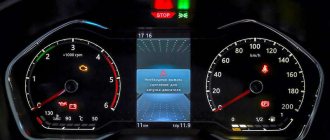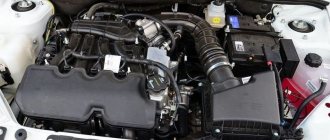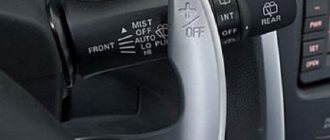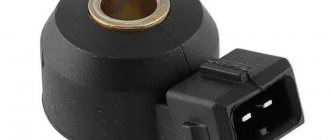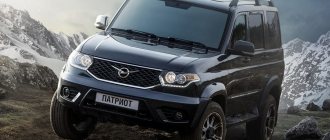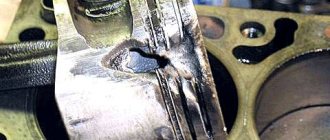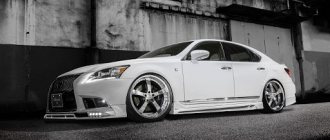Cars with a classic automatic transmission are usually less economical than their manual counterparts. Probably, over a short distance the difference in fuel costs is not so noticeable, but if you estimate the expenses for a year, the amount will be quite significant. That's why we made a selection of the most economical cars with an automatic transmission based on the rated fuel consumption in mixed driving mode (city + highway). Let’s immediately make a reservation that only gasoline versions were taken into account, since diesel modifications are traditionally not popular in Russia, and in the case of hybrids, the average fuel consumption depends too much on many factors: driving style, ambient temperature, etc.
Obviously, the more advanced the engine and transmission of the car, the lower the gasoline consumption. And the size of the car is of fundamental importance, because the more compact the model, the lower its curb weight and aerodynamic drag.
So, let's go...
12th place
Ravon R2
Ravon R2 1.3 (86 hp), 4AT - RUB 389,000.
Ravon R2 1.3 (86 hp), 4AT - RUB 389,000.
The bottom of the rating is far from being the most modern, but it is one of the smallest cars that you can buy from us. This is the Uzbek Ravon R2, the successor to the Chevrolet Spark. The five-door hatchback is equipped with a rather powerful 1.3 liter (86 hp) engine for such a baby, which is paired with an outdated 4-speed hydromechanical automatic transmission. But the Ravon R2 can boast the lowest price for the version with an automatic transmission. In the minimum “Comfort” configuration it will cost only 389,000 rubles. The average consumption according to factory data is 6.7 liters
per 100 km.
11th place
Top 10 Most economical small cars for the city
The rating of small cars for city driving includes the following manufacturers' products:
- Daewoo and Ravon (licensed versions of old models assembled in Uzbekistan);
- Russian AvtoVAZ;
- South Korean company Kia and Chevrolet (a subsidiary of GM);
- German Opel and Smart;
- French company Peugeot;
- Italian Fiat;
- Chinese company Chery.
Small cars have engines up to 1.3 liters (supercharged versions are available) and are equipped with robotic or automatic transmissions (manual transmissions are used only in inexpensive models). The cars are designed to carry a maximum of 5 people and a small amount of luggage; they are not suitable for long road trips due to their low weight and high body.
Category A cars (Mini cars according to the international classification) have a short body, which allows you to move and park in big cities.
Daewoo Matiz
At the time of sales in the late 1990s, Daewoo Matiz was the most affordable foreign car in Russia. Buyers were offered several versions, differing in equipment and engine power. Average gasoline consumption ranges from 6 to 7.5 liters, which does not meet the standards for small cars.
There are cars with air conditioning, and sometimes there are cars with front airbags and ABS.
The price for cars produced in 2014-15 with a mileage of up to 40 thousand km is 350 thousand rubles.
Lada-1111 "Oka"
Developed by the VAZ plant in the mid-1980s, this economical city car was in line with many Japanese and European models. The car was positioned as an inexpensive means of transportation for cities and was supplied to social security institutions (for transfer to disabled people).
It used an economical (by the standards of the USSR and the 1980s) carburetor engine with a power of 30 hp, later versions up to 53 hp were produced.
Average gasoline consumption ranges from 4.7 to 6.8 liters per 100 km, the price of equipment on the secondary market does not exceed 50 thousand rubles.
KIA Picanto
The South Korean concern KIA has been producing Picanto since 2004; In Russia, cars are offered by official dealers.
The manufacturer uses gasoline engines; diesel was installed on SA generation cars (it remained on the assembly line until 2010).
The price for used models in good condition starts from 270 thousand rubles, new JA generation cars cost from 775 thousand rubles.
Russian buyers are offered:
- Version with a 1-liter engine producing 67 hp. and a 5-speed gearbox burns about 4.4 liters of gasoline in the combined cycle;
- A modification with a 1.2-liter, 84-horsepower engine, equipped with an automatic transmission, has an average fuel consumption of 5.4 liters.
Opel Agila
The compact Opel Agila, built on the same platform as the Suzuki Splash and Vauxhall Agila, was produced until the end of 2015; the price for used copies does not exceed 300 thousand rubles. The Opel Agila was offered by some Opel dealers in the Russian Federation until the end of 2008.
The cars used gasoline units with a volume of 1 and 1.2 liters (average consumption 5-6 liters).
In the Russian Federation, a version with a 75-horsepower 4-cylinder in-line supercharged ecoFlex diesel engine (1.3 L) with a 5-speed manual transmission was used. The car consumes about 4.5 liters of diesel fuel and can accelerate to 165 km/h.
Peugeot 107
The Peugeot 107 class A city car is one of the top ten best fuel efficient cars. It had a hatchback body with 3 or 5 doors and front-wheel drive. The base engine was a 3-cylinder petrol engine 1KR-FE produced by Toyota Motor Industries Poland with a power of 68 hp. Average fuel consumption on the highway did not exceed 4.1 liters (regardless of the type of gearbox); in city traffic the car required up to 5.5 liters of gasoline.
A version with a 4-cylinder supercharged diesel engine DLD-414 is available in Europe. On the motorway the engine burns only 3.4 liters of fuel, and in city traffic this figure is 5.4 liters per 100 km.
The cars are equipped with airbags, power steering, power mirrors and air conditioning (air conditioning in some versions). The price of used cars on the Russian market is from 200 to 400 thousand rubles.
Smart Fortwo
The economy category includes Smart Fortwo cars designed to carry 2 passengers. The engine and transmission are located at the rear, torque is transmitted to the rear wheels.
This model has not yet been officially delivered to Russia. The cost of used copies reaches 2.2 million rubles.
Power units with power from 60 to 109 hp are available; thanks to the supercharging system and robotic transmission, the small car consumes no more than 4.5 liters of A-95 gasoline. An 81-horsepower electric drivetrain is available in Europe.
Chery QQ 6
The Chinese Chery QQ 6 is actively promoted in Russia; on the secondary market you can find units in good condition, valued by owners at 180-200 thousand rubles. The car is equipped with a 4-door sedan-type body with smooth, streamlined contours.
The car has low corrosion resistance and it is impossible to find cars with intact wheel arches or sills.
Chery QQ 6 was equipped with front airbags, power steering and manual air conditioning. Under the hood there were standardized liquid-cooled engines with a capacity of 68 and 83 horsepower with a volume of 1.1 and 1.3 liters, respectively. Only a manual 5-speed gearbox was available, the average consumption according to the manufacturer was 5.2 and 6.5 liters of gasoline (class A-92 or higher), but when using air conditioning or driving in traffic jams, the power unit requires up to 10 liters of fuel.
Fiat Panda
The compact Fiat Panda is not officially supplied to Russia; there are used cars (the price of units with a mileage of 5 to 10 years ranges from 200 to 550 thousand rubles). The Fiat Panda uses both petrol and diesel engines ranging from 0.9 to 1.4 liters (depending on generation).
The new Panda is offered in Europe; in addition to the basic version, there are Cross models with increased ground clearance, Sport (with an original body kit) and Life. The price of new cars in Germany starts from 11.99 thousand euros (about 1.09 million rubles).
Cars of the 2022 model year are equipped with engines:
- Gasoline 85-horsepower 900 cm³ TwinAir (supercharged), burning 5.7 liters of gasoline per 100 km in the average cycle;
- Hybrid 1 liter 70 hp with increased efficiency (fuel consumption 3.5 liters on the highway and 4.7 liters per 100 km in urban conditions).
Ravon R2
The Uzbek car Ravon R2 (a licensed and partially localized version of the Chevrolet Spark with an M300 body) was included in the list of cars with the lowest fuel consumption. It is only offered with a 1.3-litre 4-cylinder petrol engine producing 85bhp, mated to a 4-speed automatic transmission. The basic version costs from 768,000 rubles (standard equipment includes front airbags and an ABS braking system).
According to factory data, the minimum fuel consumption (A-92 gasoline) in the combined cycle is 6 liters; in the city the car requires up to 9-10 liters of fuel.
The plant offers versions with improved equipment (for example, with side airbags and roller curtains, a standard radio and air conditioning), which will cost up to 838 thousand rubles.
Chevrolet Spark
The subcompact Chevrolet Spark with an M300 body, which was supplied to the Russian market until 2016, was included in the ranking of the most economical passenger cars. These cars were equipped with in-line liquid-cooled gasoline engines of 1 liter and 1.2 liters (67 and 84 hp, respectively). The base version consumed an average of 5.1 and 6.3 liters of gasoline (with manual and automatic transmissions), and the version with a 1.2-liter engine burned 1-1.5 liters more gasoline.
Standard equipment included an airbag with steering wheel hub and power steering. More expensive modifications were equipped with air conditioning with an air filter and a second airbag. The average price of a used budget car for the city is about 380,000 rubles. (declared mileage up to 50 thousand km).
The fuel efficiency of a car depends on many factors; you should not rely only on factory parameters. The best examples of compact cars consume 4-5 liters of fuel on the highway only in quiet driving conditions with the air conditioning turned off and the inertia drive being used. Under standard driving conditions, cars require from 6 liters of fuel on the highway to 8 liters in city traffic. Hybrid models consume less gasoline (3-4 liters per 100 km), but the savings are offset by the risk of having to replace the lithium battery.
Kia Rio
Kia Rio 1.4 (107 hp) 4AT - from RUB 711,900.
Kia Rio 1.4 (107 hp) 4AT - from RUB 711,900.
Lada Vesta shares the penultimate line in the efficiency rating with our most popular “Koreans” Hyundai Solaris and Kia Rio. Average fuel consumption for all three is 6.6 liters
/100 km. It should also be noted that the Lada is combined with an auto-mechanical transmission (AMT) with a 106-horsepower engine. By the way, the Lada Kalina with a robotic gearbox demonstrates a similar figure, but in combination with a 4-speed hydromechanical automatic, the Tolyatti hatchback consumes noticeably more than 7.2 l/100 km.
It would seem that the 107-horsepower Solaris and Rio also have a classic 4-speed automatic, but the consumption of 6.6 liters is quite adequate for them. As for the new 6-speed automatic transmission, which is installed on the more powerful 123-horsepower modifications of Solaris and Rio, its average figure turned out to be 0.1 liters higher than that of the younger version.
10th place
Summary table with prices for new and 5-year-old used cars
The table shows current prices for new and used cars (not older than 5 years).
| № | Automobile | Price of a new car, rub. | Price of a used car, rub. |
| 1 | Peugeot 208 | 750000 | 375000 |
| 2 | Skoda Rapid | 750000 | 540000 |
| 3 | Ford Fiesta | 900000 | 450000 |
| 4 | Kia Ceed | 900000 | 599000 |
| 5 | Nissan Qashqai | 1400000 | 920000 |
| 6 | Volkswagen Passat | 1500000 | 545000 |
| 7 | Mazda 3 | 1400000 | 850000 |
| 8 | Seat Leon | 600000 | 385000 |
| 9 | KIA Picanto | 650000 | 539000 |
| 10 | Citroen C4 | 950000 | 685000 |
| 11 | Skoda Octavia | 900000 | 560000 |
| 12 | Suzuki Vitara | 1300000 | 850000 |
| 13 | Volkswagen Jetta | 800000 | 355000 |
| 14 | Kia Rio | 750000 | 479000 |
| 15 | Hyundai Solaris | 750000 | 475000 |
| 16 | Chery Kimo | 550000 | 157500 |
| 17 | Lifan Solano | 600000 | 284000 |
| 18 | Renault Logan | 600000 | 360000 |
| 19 | LADA Granta | 550000 | 345000 |
| 20 | LADA Vesta | 650000 | 475000 |
Ford Focus
Ford Focus 1.6 (105 hp), 6AT PowerShift - from RUB 1,011,000.
Ford Focus 1.6 (105 hp), 6AT PowerShift - from RUB 1,011,000.
Toyota Corolla on the Russian market competes with Ford Focus in terms of efficiency. Both cars consume an average of 6.3 liters
per 100 kilometers. Moreover, the Corolla has a 122-horsepower engine and a continuously variable transmission, which, by the way, is the only one in our rating. And Ford has a 6-speed PowerShift robot with two clutches as a gearbox. Moreover, both versions of the Ford 1.6-liter engine (105 and 125 hp) according to the manufacturer, consume the same amount of fuel in the combined cycle.
9th place
Top 15 most economical diesel cars
The economical diesel car features a supercharged transmission for improved efficiency. The best units are equipped with a 6-speed manual transmission or a dual-clutch automatic transmission. Many manufacturers do not supply diesel engine modifications to Russia due to low demand and higher prices (compared to gasoline counterparts). Additional reasons for the low level of use are the low quality of Russian fuel (especially in the outback) and increased requirements for the quality of vehicle maintenance.
Cars from categories A, B, C and D are included in the list of cars with the lowest fuel consumption. Dimensions are sufficient to transport 5 adults and luggage, increased engine power allows you to drive with a trailer or install a streamlined bag rack on the roof. Standard equipment includes airbags (from 1 to 6 depending on the model) and electronic systems that increase driving safety (including ABS with automatic brake force distribution).
Average prices for cars from the top 15 are shown in the table.
| Car manufacturer | Model | Price, thousand rubles |
| Opel | Corsa D | 250 |
| Citroen | C4 Cactus | nd |
| Peugeot | 308 | 2360 |
| KIA | Rio | n.d. |
| BMW I8 | I8 | 5500 |
| Mercedes Benz | A (W168) | 200 |
| Renault | Logan | n.d. |
| Renault | Sandero | T. |
| Seat | Leon | 1870 |
| Ford | Focus III | 700 |
| Volvo | V40 | 1000 |
| Volvo | V40 Cross Country | 800 |
| Skoda | Fast | 872 |
| Skoda | Octavia A7 | 900 |
| Ford | Mondeo Mk.V | 1000 |
Opel Corsa D
The D generation ran from 2006 to 2014, with a version of the Vauxhall Corsa also produced for the UK domestic market. The car was based on the Fiat Small platform. The manufacturer offered supercharged diesel engines of 1.3 or 1.7 liters, developing from 75 to 125 hp.
Average fuel consumption varied from 4.5 to 4.9 liters per 100 km. Diesel modifications are rare on the Russian market; the mileage is more than 150,000 km.
Citroen C4 Cactus
The Citroen C4 Cactus differs from the standard hatchback in its external design, increased ground clearance and safety elements on the sides of the doors. The car is a concept car and production has not yet begun. The designers propose to leave the 1.5-liter diesel engine with 102 or 120 hp. (depending on turbocharger settings). (depending on the settings of the turbine and fuel pump), fuel consumption on the highway is expected to be in the range of 3.1-3.6 liters per 100 km.
A number of publications have published information (unconfirmed by Citroen) about plans to install a 1.6-liter diesel engine with a capacity of 99 hp.
Peugeot 308
The new Peugeot 308 hatchback is available in standard body style and in GT style with a lowered ride height and an aerodynamic package. The cars will use a 1.5-liter diesel engine with a urea injection system.
Thanks to the electronically controlled turbocharger, petrol consumption is between 3.6 and 3.7 liters (in accordance with European CO2 A+ emission regulations).
The cost in Europe starts from 26 thousand euros; the manufacturer has not published the price in the Russian Federation.
KIA Rio
The compact sedan and hatchback KIA Rio is sold in the Russian Federation only with a gasoline power unit. The 1.5-liter diesel engine was only offered in the JB generation, produced from 2005 to 2011. The engine is equipped with a turbocharger and a 16-valve gas distribution system, its maximum power is 110 hp. at 4,000 rpm.
Diesel versions have increased low-end torque and were supplied to several Asian countries.
BMW I8
The BMW I8 concept was unveiled in 2009, and series production began four years later. Initially there were rumors that it would be equipped with a diesel unit, but all cars built received a hybrid setup. The manufacturer used a combination of an electric motor with a gasoline engine with twin turbocharging and fuel injection.
Average fuel consumption (octane number not lower than A-98) is only 2.1 liters per “hundred”, and the sports coupe can accelerate to 250 km/h.
Mercedes A-Class
The Mercedes-Benz A-Class subcompact cars entered the production program in 1997, and the W177 body-on-frame model has been in production since the beginning of 2022. Version with diesel engine OM608 (1.5 liter supercharged) with 116 hp. not offered to Russian buyers. There are copies of the W168 generation with a 1.7-liter diesel engine, produced from 1999 to 2002.
Due to the high mileage and wear of the main components, fuel consumption does not correspond to factory parameters (4.1 liters per “hundred” in mixed mode).
Renault Logan
The Renault Logan sedan offered in the Russian Federation does not use the most economical K9K engine, but similar modifications were sold in many countries in Eastern Europe. The supercharged engine produces 84 hp. with a volume of 1.5 liters (a similar unit is installed on the Duster crossover). Fuel consumption ranges from 4 to 6 liters (depending on the interior load and driving mode), the engine operates only with a manual transmission.
It is impossible to find a diesel Logan on the secondary market or in car dealerships in Russia.
Renault Sandero
Sandero differs from Logan in body and set of options; versions with 1.6-liter gasoline engines operating with a manual or automatic transmission are available for Russian buyers. The company's Romanian plant produces a version with a K9K 612 diesel engine producing 90 hp. with a cylinder volume of 1.5 liters. The truck is equipped with a supercharging system and a filter that separates soot particles from the exhaust gases.
A new or used Renault Sandero with a diesel engine has not been found on the Russian car market.
Seat Leon
The Spanish Seat Leon, built on the same platform as the Volkswagen Golf, is available in Russia in limited quantities (due to the manufacturer’s refusal to supply cars to the Russian market). In Europe it is sold in hatchback and station wagon (Sportstourer) body styles. Two modifications of the supercharged diesel engine are available: 115 and 150 hp. (volume 2 liters).
In combined mode, the 115-horsepower engine consumes just 3.9 liters per 100 km/h, allowing the car to accelerate to 100 km/h in 10.2 seconds.
Ford Focus
A veteran of the Russian market, the Ford Focus was equipped with Duratorq diesel engines ranging from 1.6 to 2.0 liters. The engines are equipped with in-line 4-cylinder units and a turbocharger with a pressure regulator. Fuel consumption in the combined cycle ranges from 4.5 to 5.5 liters (depending on power and transmission).
Cars are equipped with manual or automatic transmissions. New Focus sedans and station wagons are not offered due to Ford's withdrawal from the Russian market.
Volvo V40
The Volvo V40 estate was offered to Russian customers until 2004, after which the Swedish manufacturer removed the model from the production line. The new generation appeared only in 2012 and was equipped with supercharged and cooled diesel engines of 1.6 and 2.0 liters. The power of these engines varies from 115 to 177 hp. (depending on engine displacement). (depending on engine displacement and controller settings).
Fuel consumption in the combined cycle ranges from 3.6 to 5.2 liters (units comply with Euro 5 standards). The new V40 is not available in Russia.
Volvo V40 Cross Country
The Cross Country modification differs from the standard version by increased ground clearance and plastic lining on the sills, wheel arches and underbody. The car was advertised as a car for driving on dirt roads (the car can be considered a front-wheel drive crossover).
The same engines were used as for the standard Volvo V40, fuel consumption in combined mode ranges from 3.6 to 5.2 liters (according to the manufacturer) The V40 Cross Country is rarely found on the secondary market.
Skoda Rapid 2017
The compact Skoda Rapid liftback is produced in Russia with 1.6-liter (atmospheric) or 1.4-liter (supercharged) gasoline units. In Europe, a modification with a diesel engine with a power of 90 or 105 hp is offered. (version with pre-select and manual transmission respectively).
The engine has a gray cast iron cylinder block, a supercharging system with intercooler and a 16-valve valve drive.
Average diesel fuel consumption is 4.3 liters, and the model is not yet available in Russia. Rapid production will take place in Russia only until 2022.
Skoda Octavia
The Skoda Octavia category C is available in 5-door, station wagon and liftback body styles. Since 1997, four generations have been introduced, which differed in appearance and range of power units. The third generation cars (assembled for the Russian market in Nizhny Novgorod) used a 143-horsepower diesel engine that consumed 5.1 liters of fuel in mixed mode.
The new generation A8 will use engines similar to those used in the Seat Leon.
Ford Mondeo 2014
The 2014 Mondeo sedan belonged to the Mk.V generation, based on the Ford CD4 platform. For the Russian market, the manufacturer limited itself to gasoline units (atmospheric 2.5-liter and supercharged EcoBoost series). For Europe, 2-liter supercharged EcoBlue diesel engines with 150 or 190 hp are available. Urea injection and a start-stop system are available, with average starting volumes ranging from 4.7 to 5.2 liters.
In Russia, diesel Mondeo Mk.V 2015 model year are available with a mileage of at least 150 thousand km.
Ford Fiesta
Ford Fiesta 1.6 (105 hp) 6AT PowerShift - from RUB 768,000.
Ford Fiesta 1.6 (105 hp) 6AT PowerShift - from RUB 768,000.
Slightly lower fuel consumption - 5.9 l
for a hundred - demonstrates the 105-horsepower Fiesta. The difference of 200 kg in curb weight compared to the Focus did its job, bringing the car to ninth position.
8th place
Comparison of the presented cars
For a clear comparison of the presented models, let’s compare them in the table below.
| Model | Fuel consumption, l/100km | Acceleration to 100 km, sec | Engine, l/s | Box | Price, rub |
| Chevrolet Spark | 6,5 | 12,9 | 82 | mechanical | 509 000 |
| Nissan Versa | 6,3 | 11,1 | 109 | mechanical | 828 000 |
| Ford Focus | 6,2 | 12,3 | 85 | mechanical | 731 000 |
| Hyundai Elantra | 6,1 | 10,1 | 93,8 | mechanical | 994 000 |
| Honda Fit | 5,7 | 10,1 | 100 | mechanical | 780 000 |
| Volkswagen Polo | 5,6 | 11,2 | 90 | mechanical | 609 900 |
| Mitsubishi Mirage | 5,0 | 11,5 | 78 | variable speed drive | 650 000 |
Volkswagen Polo
Volkswagen Polo 1.4 TSI (125 hp), 7DSG - from RUB 856,900.
Volkswagen Polo 1.4 TSI (125 hp), 7DSG - from RUB 856,900.
The Kaluga-assembled Volkswagen Polo sedan is even a little more economical. Its turbo version with a 1.4 TSI engine paired with a 7-speed DSG robot consumes an average of 5.7 liters
for every 100 km. Do you believe it? It’s quite possible if you drive in eco-rally mode, but if you overdo it once or twice with pressing the accelerator pedal, all the savings will go down the drain. It’s good that there is an alternative: a tandem of a 1.6-liter naturally aspirated engine (110 hp) and a 6-speed automatic will require, according to the manufacturer, a little more - 5.9 liters per hundred. But achieving such an indicator in practice is much easier.
Some tips to help save fuel
It is not enough to buy a car that consumes a small amount of gasoline or diesel.
It is important that the owner knows how to operate the equipment correctly, otherwise it will be impossible to achieve the technical characteristics specified by the manufacturer. However, this will not be difficult to do if you follow the recommendations of experts:
- It is necessary to brake and start smoothly. If you press the pedal sharply, this will lead to an increase in fuel consumption.
- Shift into a higher gear. This is especially true when driving on the highway. To save fuel, you need to accelerate as soon as possible and engage a higher gear.
- Owners of models with automatic transmission should avoid the “Kickdown” or “Sport” modes.
- It is important to monitor tire pressure. An insufficient value will lead to increased consumption.
- Regularly check the technical condition of the car. For example, a large gap between spark plugs causes excessive consumption of gasoline or diesel.
If you change your driving style and monitor the health of your vehicle, you can significantly reduce your fuel costs. Manufacturers take into account the wishes of thrifty car enthusiasts and offer various models, among which everyone will find a “swallow” to their liking.
The most reliable
From Mercedes. The concern produced the legendary OM602 engine. These five-cylinder, two-valve power units were produced for just over twenty years, from 1985 to 2002. They were installed on SUVs, vans and other vehicles. So, they can still be seen on Mercedes in the back of the W124 or Sprinter van.
Such motors were distinguished by their efficiency and reliability. Despite the small power, it reached 130 horsepower, such power units had very impressive technical characteristics. Thus, the mileage of some copies exceeds 1,500,000 kilometers. Record figures exceeded 2 million kilometers on one engine.
From BMW. The Bavarian concern produces not only the most powerful, but also the most reliable engines. Thus, six-cylinder diesel engines are considered one of the most reliable power units. They were installed on Range Rover, E46 and other cars, including those of subsidiaries. These power units were produced for exactly 10 years - from 1998 to 2008.
The power of diesel engines is greater than that of analogues from the Mercedes concern. Depending on the model, it varies between 201-286 horsepower. The service life of the motors is quite high. They may have quite a lot of small problems, but there are practically no major breakdowns. Thus, engines work perfectly without breakdowns up to a mileage of 400-500 thousand kilometers.
Opel Astra
The Opel Astra is also among the most economical gasoline cars. It’s worth mentioning right away that this model has over twenty years of history and several modifications, so not every Astra can be mistaken for an economical car with your eyes closed. But in terms of efficiency, it is worth considering the new Opel Astra J with a 1.4-liter engine. This model, with its volume and power of 100 hp. capable of reaching speeds of up to 183 km/h, and fuel consumption will be 7.1 liters. in the city and 4.6 l. along the highway. The ratio of indicators is incredibly favorable, and if you also take into account the high reliability (in its class) of this car, then its purchase will be justified.
Mini-rating of the best diesel engines on the market
All the best units can be divided into several groups according to country of origin:
- Asian. The Toyota and Hyundai brands are constantly working on high dynamic performance, while not forgetting about reliability. Their products are resistant to low quality fuel, are durable and have high efficiency.
- American. Well-known companies Chrysler and Ford are trying to combine important characteristics: they are working on power and efficiency, while trying to reduce fuel consumption. Their units are powerful and reliable, while consuming little.
- German. The Mercedes and BMW brands are famous for the excellent quality inherent in all products from Germany. The concerns use the most modern technologies, so their products are distinguished by high technological performance and reliability.
Depending on the evaluation parameters, several best diesel engines can be identified.
